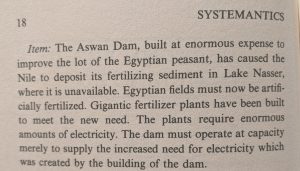Is the Aswan Dam a perfect example of unintended consequences? No.
We innately love a just-so explanation for why things are the way they are. At the same time, we also know that the world is a complex place. That’s why when I saw the below quotation about second-level effects from Egypt’s Aswan Dam, I was both intrigued and skeptical.

Here’s the story, which I learned from… social media.
This is a page from the book Systemantics, by John Gall. The book itself is a mini classic (one of my favorite parts is actually the paragraph that comes right after the above, plus the Generalized Uncertainty Principle, and the idea that “the system does not do what it says it does” and on and on…). The above quote though is a stand-alone claim (certainly taken as true and passed along) that should be able to be tested. (If you read the book, you’ll even doubt whether Gall was totally serious in his claim.) But I was so interested in Gall’s idea that I decided to think through the ideas proposed in those few sentences and then learn more about the dam.
On the surface, Gall’s quote sounds like a strong example of unintended consequences, with their origin in a blindness to potential second-level effects of complex systems. But now that I’m diving into this field (if it is a field) I want a better understanding of the situations that created these unintended consequences.
Here is a selection of what I disagree with in the quotation from Gall above.
Fertilizer Usage Increased for Other Reasons
Fertilizer usage increased globally. “The [fertilizer] plants require enormous amounts of electricity. The dam must operate at capacity merely to supply the increased need for electricity which was created by the building of the dam.” But fertilizer use also increased around the world, not just in Egypt. Was this from every country producing its own large dam project and suffering similar consequences? No. It was from many other factors, including better technology to produce fertilizer, the search for higher crop outputs per acre, increased food demand, subsidies, and all manner of things.
Increased agricultural production. After the dam was built, two to three crops started to be grown annually, rather than one. More land started to be used for agriculture.
There is an average of a 91% increase in Egyptian fertilizer production in the 10 years 1965 – 1975. For now I believe that this increase can be as much attributed to general increased agriculture production (population growth, more arable land after creation of the dam, more fertilizer used per acre as increased output seen) and production choice (exports, subsidies, tariffs, and more) as the pure need for more fertilizer “created” by the Aswan Dam. Fertilizer use continues to increase, and at a more rapid rate, into the 1980s. By 1983/84, fertilizer consumption (depending on type) is 2x to 9x that of 1975, when Gall wrote those sentences. This would mean that Egypt would need many more Aswan Dams worth of electricity production just to accommodate fertilizer consumption (or would need to import all extra fertilizer). That is, if the quotation isn’t leading us astray.
You can also look at fertilizer consumption in Egypt here. Set the timescale to 1960 – 1975 to get a view of what it was before the Aswan Dam, to completion in 1971, to 1975 when Systematics was written. There is an increase in consumption, but nothing like what I expected from Gall’s quotation above.
If anything, this growth in fertilizer consumption mirrors the growth in Egypt’s population.
Price of fertilizer. There is another economic change in the shift to fertilizer use and away from natural sources of nutrients, like rivers, and even of doing nothing. That is of the price of fertilizer, which has had a couple spikes (quick tripling and then crashing in price) over the past 50 years. The risks could be deeper depending on whether the fertilizer is also imported or there is foreign currency exposure for its purchase. Those are possible second-level effects, but harder to convey in a short quote. There are prices at which it is worth devoting all hydroelectric energy to fertilizer production. Again, I don’t think that all the dam’s electricity production actually went to fertilizer production.
On the nutrient value of the Nile. Yes, the annual flood of the Nile did increase agricultural production historically but the quote above makes it seem like keeping things as is (no Aswan High Dam) would have been a better choice. But would the Nile’s flooding have been enough to meet increased agricultural production demands? A clue is here: “The nutrient value added to the land by the sediment was only 6,000 tons of potash, 7,000 tons of phosphorus pentoxide and 17,000 tons of nitrogen. These amounts are insignificant compared to what is needed to reach the yields achieved today in Egypt’s irrigation.” (See the “Loss of sediments” section)
Economic distortions. Import taxes on fertilizer were high in Egypt in the 1970s. There were also subsidies on chemical fertilizers. I couldn’t find good data on these, but economic policy could explain the change as well.
In a paper titled Impacts of the High Aswan Dam, the authors note the wide difference in the perception of the Aswan Dam depending on whether you speak to Egyptians or non-Egyptians. Interesting.
Other potential impacts from the dam that I didn’t cover and which weren’t addressed in the quote: increased cost of drinking water treatment; negative impact on the red-brick industry; unclear, but possible negative impact on sardines fishing in the Mediterranean. And on and on…
So I don’t see the Aswan Dam as a pure example of unintended consequences. The quote at the top is misleading. Note: I had no knowledge of the dam’s impact before seeing the above quote from Systemantics posted on Twitter. I was inclined to look into the dam’s history because the explanation given seemed too perfect. (Please help correct errors that you find.)